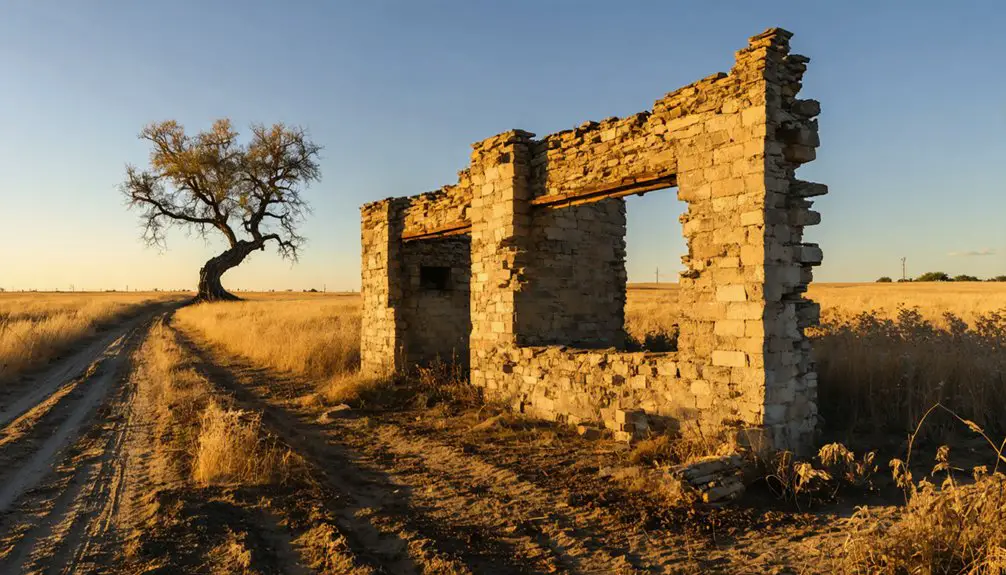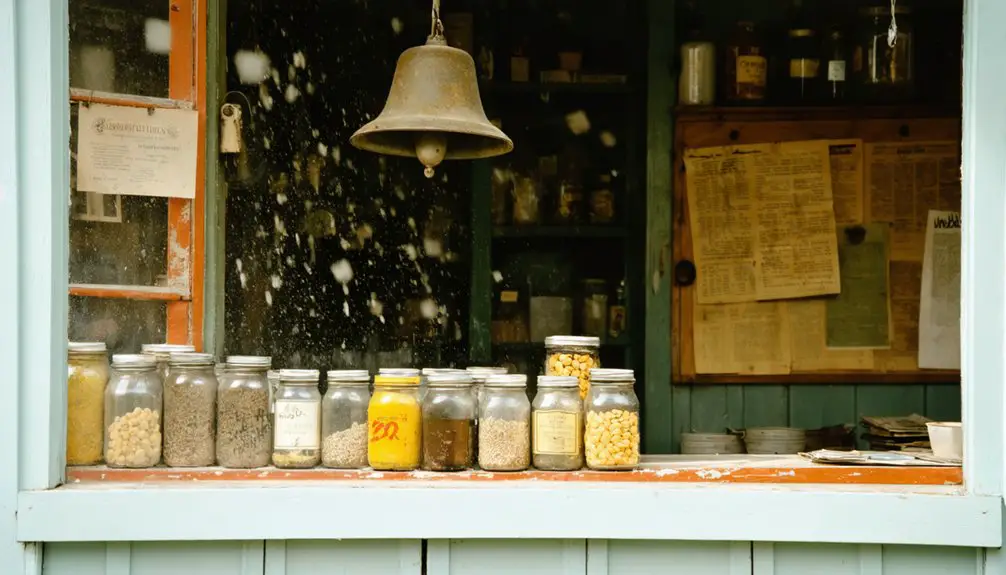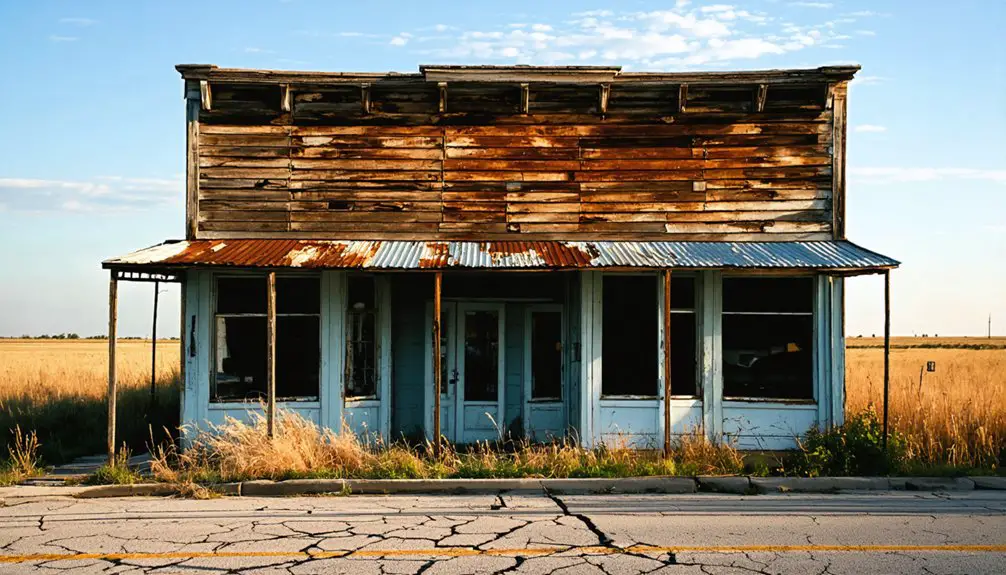You’ll find Trousdale, Kansas, established in 1915 as a railroad junction town, named after local landowner Mr. Trousdale. The town once thrived with two grocery stores, a bank, and grain elevators supporting its agricultural economy. Despite producing NFL coach Bruce DeHaven and maintaining a strong Methodist church community, Trousdale declined after railroad rerouting and the Great Depression. Today, few structures remain standing, though the rebuilt Methodist Church and scattered farmhouses tell a deeper story of resilience.
Key Takeaways
- Founded in 1915 as a railroad junction town, Trousdale thrived initially with diverse businesses but declined after railroad rerouting and economic hardships.
- Only a few structures remain today, including an abandoned gas station, auto parts store, and the Methodist Church rebuilt after 2007.
- The Great Depression, loss of railroad commerce, and shift to highway transportation contributed to Trousdale’s transformation into a ghost town.
- Most buildings are now abandoned with visible urban decay, though eight homes still support ongoing agricultural activities in the area.
- Original street layout remains traceable despite overgrowth, while surrounding farmland continues to be actively cultivated using modern techniques.
The Birth of a Railroad Town
When the railroad junction began construction in 1915, Trousdale emerged as a new settlement in Edwards County, Kansas. You’ll find the town’s name originated from Mr. Trousdale, a Newton landowner who influenced its early development. The strategic location along the rail line connected neighboring communities, making it a crucial transportation hub.
As the railroad junction took shape, you’d have witnessed the rapid development of town infrastructure. Essential services quickly followed, including schools and financial institutions to serve the growing population. The town would later require a disambiguation page to distinguish it from other locations sharing the Trousdale name. The area features the fascinating Trousdale Caves which draw visitors interested in exploring the region’s unique geological formations.
By 1916, postal services were established to support the burgeoning railroad commerce. The town’s economy centered on agricultural shipping, with two grain elevators built to capitalize on the rail access.
Trousdale’s birth marked a classic example of how railroads transformed empty prairies into bustling communities.
Early Days of Growth and Promise
After establishing the railroad junction in 1915, Trousdale quickly blossomed into a promising community with diverse commercial enterprises.
You’d find a bustling town center with retail shops, a post office, and a bank serving the growing population. Just as with early Potawatomi ghost towns, Trousdale’s location and development were heavily influenced by its proximity to railway lines.
Today, only a few houses and scattered remnants of businesses remain standing in the unincorporated settlement. The town’s early community bonds formed around the Methodist Church and local businesses, while two grain elevators marked Trousdale’s importance as an agricultural hub.
Notable Landmarks and Businesses
Today’s Trousdale bears little resemblance to its former bustling self, with just a handful of structures remaining as evidence to its past.
You’ll find an old gas station and auto parts store among the few businesses still standing, though they’re shadows of the town’s previous commercial importance.
The town once thrived with two grocery stores and various commercial establishments.
Like many towns during the Great Depression, Trousdale saw its prominence fade as economic hardships took their toll.
The Trousdale United Methodist Church stands as the town’s most significant landmark, serving as a spiritual and social anchor for remaining residents and area farmers.
After suffering damage in the 2007 Greensburg tornado, the church was rebuilt while preserving elements of its original architecture.
Its landmark significance extends beyond religious services, as it continues to draw former residents back for special occasions like weddings and anniversaries.
This enduring presence contrasts sharply with the business evolution that’s seen most other local establishments vanish over time.
The Role of Agriculture
Since its establishment alongside the railroad junction in 1915, Trousdale’s identity has been fundamentally shaped by agriculture.
You’ll find evidence of this in the two grain elevators that once dominated the townscape, serving as essential hubs for the region’s robust grain production. The community’s early agricultural roots drew from Kansas’s diverse farming heritage, which included beans, squash, and corn, though wheat eventually became the primary crop.
As farming practices evolved, you’d have witnessed significant mechanization trends transform the local landscape. The W.J. Trousdale and Company produced the Jayhawker Crusher to help local farmers prepare livestock feed.
While businesses and population declined over time, family farms remained the backbone of Trousdale’s economy well into the 2000s. The 1927 electrification modernized operations, and by 2006, grain storage facilities and equipment repair shops still supported the persistent farming community.
Local Heroes and Athletic Legacy
The small town of Trousdale produced remarkable athletic talent, most especially NFL coach Bruce DeHaven and Raiders’ offensive line coach Ollie Spencer. DeHaven, who grew up playing multiple sports in Trousdale, went on to achieve a distinguished 25-year NFL coaching career, including four Super Bowl appearances with the Buffalo Bills.
You’ll find that local athletes brought significant community pride to this family-oriented town. The 8-man football team‘s success, including an undefeated season in 1965, exemplified the competitive spirit that defined Trousdale’s sports culture. Like many of Harvey County’s lost communities, Trousdale faced economic and demographic challenges that led to its decline.
Despite its small size, the community rallied around its youth athletes, fostering values of perseverance and teamwork. Even as Trousdale transformed into a ghost town, its athletic legacy endures through the achievements of its hometown heroes and their continued connection to their roots.
The Great Depression’s Impact
When harsh economic realities gripped America in 1929, Trousdale felt the devastating impact of both financial collapse and environmental disaster. You’d have witnessed the local bank’s closure, reflecting the broader crisis that plagued rural Kansas.
Economic hardships intensified as nearly 25% of the nation’s workforce lost their jobs by 1933, drastically reducing wages and farm income. The return of rainfall in 1939 finally brought relief to the struggling farming community.
The community’s resilience was tested further as the Dust Bowl ravaged the region’s agricultural foundation. Massive dust storms destroyed crops and livestock, while prolonged drought led to widespread farm foreclosures. Children and adults alike were forced to wear protective dust masks when venturing outdoors.
Surviving Natural Disasters

Natural disasters have repeatedly tested Trousdale’s resilience, with the 2007 Greensburg tornado delivering the most devastating blow to this Kansas settlement.
You’ll find that despite the destruction, the community’s spirit remained unbroken as families like the DeHavens and Schultzes returned to rebuild and continue farming.
The town’s disaster preparedness evolved through its location in Tornado Alley, where you’d face not just twisters but also droughts and floods.
Living in Tornado Alley taught Trousdale’s people to prepare for everything nature could throw at them, from twisters to drought.
After the 2007 tornado, you would’ve seen remarkable community resilience as residents banded together to reconstruct their church, incorporating pieces of the original building.
While the disaster accelerated population decline and reduced business operations, surviving families maintained their agricultural ties through mutual support networks, proving that even nature’s fury couldn’t completely erase Trousdale’s determined spirit.
Transportation Changes and Decline
Since railroad lines initially brought prosperity to small Kansas settlements, their eventual rerouting spelled disaster for Trousdale’s future.
You’d have witnessed a dramatic transportation evolution as the town’s rail-dependent economy faltered when routes shifted elsewhere. The rise of automobiles and improved highways further isolated Trousdale when Highway 54 bypassed the community.
The economic decline accelerated as businesses and residents relocated to larger towns with better transportation access. Without rail commerce and highway traffic, Trousdale lost crucial services – schools, churches, and stores shut down one by one.
You can trace the town’s fate to these pivotal transportation changes, as locals moved closer to emerging transportation hubs. Like many other rural Kansas communities, Trousdale couldn’t survive being cut off from the crucial lifelines of rail and road networks.
Community Spirit Through the Years

As the Anthony and Northern Railroad arrived in 1915, Trousdale emerged as a vibrant hub where community spirit flourished through its churches, schools, and social gatherings.
You’d find residents actively participating in local events, from church services to 8-man football games that brought pride to the town in the 1960s.
The community’s resilience shone through figures like NFL coach Bruce DeHaven and football coach Ollie Spencer, who embodied the town’s commitment to youth development.
After the 2007 Greensburg tornado, you’ll see how the collective memory of Trousdale’s strength inspired residents to rebuild their church, incorporating elements from the original structure.
Even today, despite population decline, you can witness the town’s enduring spirit through annual reunions, preserved historical sites, and active volunteer services.
Modern Day Remnants
Today you’ll find a handful of standing structures in Trousdale, including an abandoned gas station, auto parts store, and a church that remains as the town’s primary landmark.
You can still spot occasional agricultural activity in the surrounding areas, though the once-bustling commercial center has largely disappeared.
While most social institutions have vanished, the church continues to serve as an anchor for the few remaining residents who call this ghost town home.
Standing Structures Today
Several structures remain standing in the ghost town of Trousdale, Kansas, offering glimpses into its former liveliness.
You’ll find an old gas station and auto parts store among the remaining architecture, their weathered facades telling stories of busier days. A church building stands as one of the most prominent landmarks, while scattered residential houses dot the landscape, most abandoned or barely inhabited.
The urban decay is evident throughout the town, with deteriorating wooden structures, broken windows, and faded signs characterizing the scene.
You can trace the original street layout, though many roads have surrendered to grass and weeds. While utility poles still stand sentinel over the quiet streets, the railroad tracks that once brought life to Trousdale have largely disappeared, leaving only memories of the town’s vibrant past.
Agriculture Still Persists
Despite its ghost town status, Trousdale maintains a robust agricultural presence. You’ll find about eight homes where farming families continue their generational legacy through modern farming techniques.
The 2006 landscape featured essential agricultural infrastructure, including a grain storage facility, repair shop, and fuel outlet supporting local operations.
While the post office closed in 1967 and a 2007 tornado caused significant damage, agricultural resilience prevails. Family-owned farmland stretches across the area, supporting typical western Kansas crop production.
The 1927 high line installation enabled farm modernization, while existing repair services and fuel access guarantee continued productivity. Though the railroad’s gone quiet, road networks keep crop transportation flowing.
You’ll still witness the deep-rooted farming culture that’s defined Trousdale since its early days.
Church Anchors Community
Standing as a proof of community resilience, the Trousdale Methodist Church remains the town’s sole spiritual center and gathering place.
Dating back to the early 20th century, the church has outlasted every other institution in town, including the school, bank, and post office.
You’ll find deep church history woven into Trousdale’s story since 1915, when it first served the railroad junction community.
Even after a devastating tornado in 2007 severely damaged the structure, locals rallied to rebuild it, incorporating features from the original building.
Today, it’s where you’ll witness the community’s enduring spirit through weddings, anniversaries, and memorials.
While other rural establishments have vanished, this Methodist church continues to unite scattered farm families and preserve their shared heritage.
Frequently Asked Questions
What Was the Total Population of Trousdale at Its Peak?
You’ll find that historical significance records don’t specify exact numbers, but based on infrastructure and population decline patterns, Trousdale’s peak population was approximately 100-200 residents during the 1910s-1930s.
Are There Any Annual Events or Reunions Still Held in Trousdale?
Time marches on, but you won’t find any community gatherings or historical celebrations happening there anymore. The ghost town’s limited structures and sparse population don’t support organized annual events or reunions.
How Many Students Attended Trousdale High School Before It Closed?
While exact student enrollment numbers aren’t documented, you can estimate Trousdale High School had fewer than 50 students before its school closure, typical of comparable rural Kansas schools during that era.
What Native American Tribes Originally Inhabited the Trousdale Area?
You’ll find the Kanza (Kaw) tribe were the primary Native tribes in this area, maintaining settlements along the Kansas River valley. They shared cultural heritage with neighboring Pawnee, Osage, and Comanche peoples.
When Was the Last New House Built in Trousdale?
While specific last construction dates aren’t documented, you’ll find housing trends show no new homes built since well before the 2007 tornado, with the last likely construction occurring mid-20th century.
References
- https://en.wikipedia.org/wiki/Trousdale
- https://www.youtube.com/watch?v=x0G1GMLRrF8
- http://kansasghosttowns.blogspot.com/2011/06/trousdale-kansas.html
- http://kansasghosttowns.blogspot.com/2011/06/
- http://vanishing-kansas.blogspot.com/2013/01/trousdale-ks.html
- https://spmhays.com/concrete-sidewalks/trousdale/kansas
- https://kids.kiddle.co/Trousdale
- https://legendsofkansas.com/wyandotte-county-extinct-towns/
- https://www.potawatomi.org/blog/2021/04/09/remembering-potawatomi-ghost-towns/
- https://www.youtube.com/watch?v=PfThSLZOtqg



